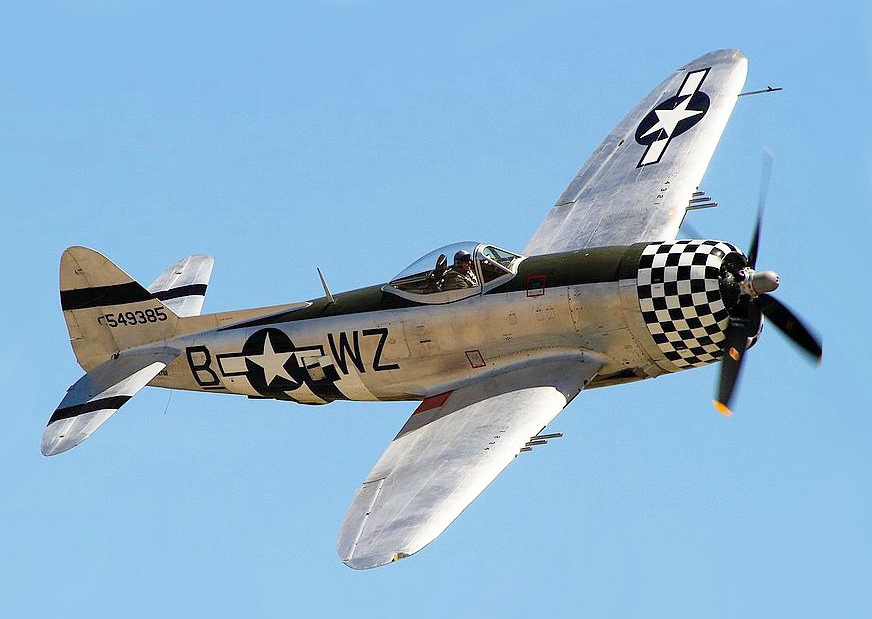The Republic P-47D Thunderbolt, commonly known simply as the “Jug,” was a formidable fighter-bomber aircraft used by the United States Army Air Forces (USAAF) during World War II. It was renowned for its ruggedness, firepower, and effectiveness in ground attack missions, making it one of the most versatile aircraft of the war.

Development and Design
The P-47 Thunderbolt was designed by Republic Aviation in the early 1940s in response to a USAAF requirement for a high-altitude interceptor. The aircraft’s development was led by Alexander Kartveli, who aimed to create a fighter with exceptional speed, range, and armament capabilities.
The P-47D variant, which became the most produced model, featured a turbocharged Pratt & Whitney R-2800 Double Wasp radial engine. This engine gave the Thunderbolt significant power, with up to 2,430 horsepower in later models. The P-47D had a wingspan of 40 feet 9 inches (12.4 meters) and a length of 36 feet 1 inch (11 meters). Its maximum speed was around 426 mph (686 km/h) at 30,000 feet (9,100 meters), and it could reach altitudes above 40,000 feet (12,200 meters).
Armament and Performance
One of the standout features of the P-47D Thunderbolt was its firepower. It was heavily armed with eight .50 caliber Browning M2 machine guns, four mounted in each wing. This impressive armament made the Thunderbolt particularly effective against enemy aircraft and ground targets alike. Later models could also carry bombs, rockets, or drop tanks under the wings, enhancing its ground attack capabilities.
The P-47D Thunderbolt was known for its rugged construction, which allowed it to absorb significant battle damage and return safely to base. Its robust airframe and radial engine made it suitable for long-range escort missions, where it provided protection to Allied bombers deep into enemy territory.
Operational History
The P-47D Thunderbolt saw extensive combat during World War II, primarily in the European Theater of Operations (ETO) and later in the Pacific Theater. It was used by USAAF fighter groups to escort bombers such as the B-17 Flying Fortress and B-24 Liberator during daylight bombing raids over Europe. The Thunderbolt’s long range and heavy armament made it effective in engaging German fighters like the Messerschmitt Bf 109 and Focke-Wulf Fw 190.
In addition to its role as a bomber escort, the P-47D Thunderbolt excelled in ground attack missions. It conducted strafing runs against enemy airfields, troops, and armored vehicles, contributing significantly to Allied efforts on the ground. The Thunderbolt’s ability to absorb damage and deliver powerful firepower made it a feared opponent and a trusted ally among Allied forces.
Variants and Legacy
Throughout its production run, the P-47 Thunderbolt underwent several variants and improvements:
- P-47D-1 to P-47D-40: Various subvariants with changes in equipment, engine upgrades, and minor modifications.
- P-47M: High-altitude variant with a more powerful engine and improved performance at altitude.
- P-47N: Long-range variant designed for operations in the Pacific, featuring a larger wingspan and increased fuel capacity.
After World War II, the P-47 Thunderbolt continued to serve in various air forces around the world, including post-war air forces in Europe and South America. It left a lasting legacy as one of the most effective and versatile fighter-bombers of its time, demonstrating the importance of ruggedness, firepower, and range in combat aircraft design.
Conclusion
The Republic P-47D Thunderbolt was a cornerstone of Allied air power during World War II, renowned for its ruggedness, firepower, and operational versatility. It played a crucial role in escorting bombers, conducting ground attack missions, and providing close air support to ground forces. The Thunderbolt’s contributions to Allied victory in Europe and the Pacific underscore its significance in military aviation history, leaving an enduring legacy as a symbol of American ingenuity and determination during the war.

